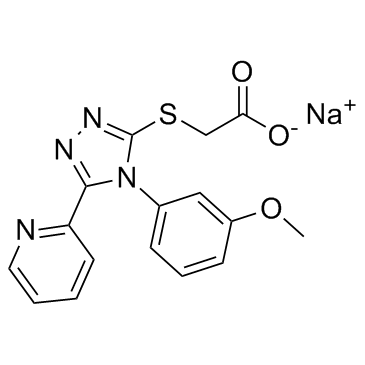All AbMole products are for research use only, cannot be used for human consumption.

In vitro: Chemical-induced read through of premature stop codons might be exploited as a potential treatment strategy for genetic disorders caused by nonsense mutations. GJ072 is a novel read-through compound (RTC). GJ072 shows activity comparable to stop codons (TGA, TAG, and TAA) PTC124 and RTC13. GJ072 induces ATM kinase on both TGA and TAG stop codons and restored ATMpSer1981 autophosphorylation and SMC1pSer966 transphosphorylation as measured by FACS. GJ072 is active in A-T cells with a homozygous TAA mutation. GJ072 is able to induce detectable full-length ATM protein in treated A-T cells. Early structure-activity relationship studies generates eight active analogs of GJ072. Some GJ072 analogs (e.g., GJ103, GJ106, GJ109, and GJ111) consistently demonstrates their activities in all three PTCs by both FCATMpSer1981 and IRIF assays. GJ071 and GJ072 and some of their analogs (such as GJ103) have similar read-through activity as RTC13 or RTC14, but are more tolerable than RTC13 and RTC14 to A-T cells. GJ103 does not show obvious cytotoxicity in A-T cells at concentration as high as 300 μM.
In vivo: GJ103 sodium salt is water soluble, making it much easier to work with in in vivo experiments.
| Molecular Weight | 364.35 |
| Formula | C16H13N4NaO3S |
| CAS Number | 1459687-96-7 |
| Solubility (25°C) | 34 mg/mL in DMSO |
| Storage |
Powder -20°C 3 years ; 4°C 2 years In solvent -80°C 6 months ; -20°C 1 month |
| Related Products |
|---|
| Myoglobin (from equine skeletal muscle)
Myoglobin is a small molecular pigment protein formed by binding globin to Heme, which can be reversibly bound to oxygen to form MbO2, MbO2 is called oxymyoglobin, and Mb is called deoxymyoglobin. Myoglobin has the role of transporting and storing oxygen in muscle cells. |
| Hemoglobin (from bovine blood)
Hemoglobin is a iron-containing protein in red blood cells with oxygen binding properties. Hemoglobin is an inducer of HO-1. Hemoglobin consits of heme, which binds to oxygen. Hemoglobin also transports other gases, such as carbon dioxide, nitric oxide, hydrogen sulfide and sulfide. |
| Diethylenetriaminepentaacetic dianhydride
Diethylenetriaminepentaacetic dianhydride (DTPA anhydride) is a bifunctional chelator whose anhydride can react with amino groups in proteins (such as lysine residues) to form stable amide bonds. Diethylenetriaminepentaacetic dianhydride (DTPA anhydride) can also bind to radionuclides to synthesize radionuclide-labeled drug conjugates (RDCs). |
| 3-Phenylthiophene
3-Phenylthiophene is a biochemical material that can be used in scientific research. 3-Phenylthiophene is a conducting polymer precursor. |
| DSPE-PEG-FA
DSPE-PEG2K-FA is a PEG derivative containing folic acid. DSPE-PEG2K-FA has a targeting effect and can bind to folic acid receptors in cancer cells. DSPE-PEG2K-FA forms micelles/lipid bilayers and can be used in research on targeted drug delivery systems. |
All AbMole products are for research use only, cannot be used for human consumption or veterinary use. We do not provide products or services to individuals. Please comply with the intended use and do not use AbMole products for any other purpose.


Products are for research use only. Not for human use. We do not sell to patients.
© Copyright 2010-2024 AbMole BioScience. All Rights Reserved.
